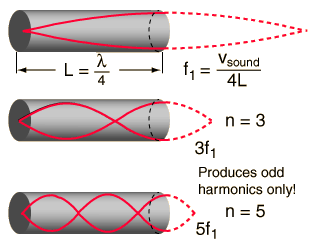Closed Cylinder Air Column
A closed cylindrical air column will produce resonant standing waves at a fundamental frequency and at odd harmonics. The closed end is constrained to be a node of the wave and the open end is of course an antinode. This makes the fundamental mode such that the wavelength is four times the length of the air column. The constraint of the closed end prevents the column from producing the even harmonics. |

|
The clarinet consists of an approximate closed cylinder, and this makes clarinet acoustics quite different from the other woodwind instruments. As can be seen from a sample waveform, the even harmonics missing from the tone, at least for the lower range of the instrument. The upper register of notes which may be played with this instrument start at the third harmonic of the air column rather than at the second harmonic as in the other woodwinds.
| Comparison of air columns | Resonance tube experiment |
Wave concepts
Resonance concepts
| HyperPhysics***** Sound | R Nave |